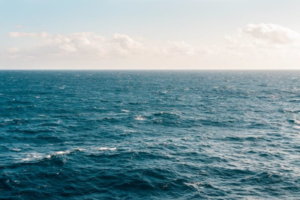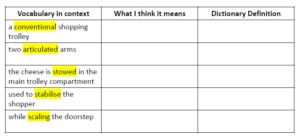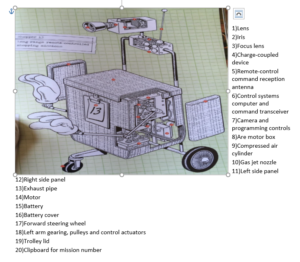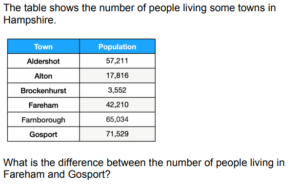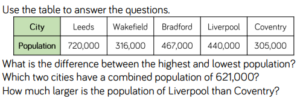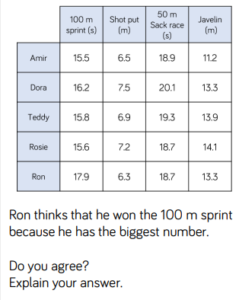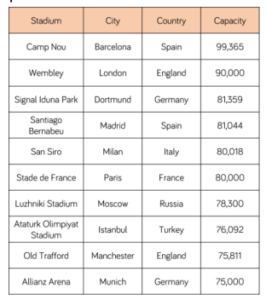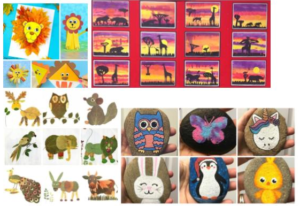Hello Year 5
We hope you have all had a fantastic half term break and that you have been enjoying the amazing weather we have had! Below you will find all of your home learning activities for this week – we hope you enjoy completing them. Don’t forget to email through your favourite piece of work so that we can see all of the great learning you have done.
Year 5 home learning activities for week beginning Monday 1st June
Reading
Reading Comprehension
Sea Fever, by John Masefield
Sea Fever
I must go down to the seas again, to the lonely sea and the sky,
And all I ask is a tall ship and a star to steer her by;
And the wheel’s kick and the wind’s song and the white sail’s shaking,
And a grey mist on the sea’s face, and a grey dawn breaking.
I must go down to the seas again, for the call of the running tide
Is a wild call and a clear call that may not be denied;
And all I ask is a windy day with the white clouds flying,
And the flung spray and the blown spume, and the sea-gulls crying.
I must go down to the seas again, to the vagrant gypsy life,
To the gull’s way and the whale’s way where the wind’s like a whetted knife;
And all I ask is a merry yarn from a laughing fellow-rover,
And quiet sleep and a sweet dream when the long trick’s over.
Lesson 1: Read aloud and enjoy together
This is probably John Masefield’s most famous poem. It was written at the start of the twentieth century.
Enjoy reading the poem aloud, paying attention to its rhythm and rhyme. Read it several times to get the feel of the poem.
If you can, try alternating reading aloud with another person. You could perhaps read a line or a verse in turn.
Discuss any tricky vocabulary in the poem.
Lesson 2: Respond to poetry
Task 1: Read the poem again and discuss the following questions to help you respond to it:
Q1: Do you like the poem? Why?
Q2: How does the poem make you feel? Why?
Q3: Does the poem make sense to you?
Q4: Does the poem have a story or a message? What is it?
Q5: Have you read a poem like this before? How are they similar and different?
Q6: Can you think of another title for the poem?
Task 2: Clarify vocabulary
Think about the vocabulary that could be tricky in the poem. You may already have discussed some of these words, but it is useful to carry out exercises like the example below to help fix the words in your memory.
| Word | Definition |
| Use In a sentence | |
Example:
| Rover | A person who spends their time wandering |
| The rover strolled through the town without a care in the world | |
Lesson 3: Language for effect
John Masefield makes effective use of figurative language in the poem. He uses personification when referring to nature: “the sea’s face” and “the wind’s song”, for example.
Q1: What is the effect of this personification? What does it tells us about how the narrator views the sea and the natural world around it?
Q2: Can you find an example of alliteration? (Alliteration is the repetition of consonant sounds in quick succession.)
Q3: Can you find an example of repetition in the poem? What effect does this have on the reader?
Q4: Are there any other examples of figurative language? Annotate your copy of the poem to show where figurative language has been used.
Lesson 4: Get creative!
Task: Create a poetry mood board for Sea Fever, using images from the Internet or your own drawings. For each image, annotate the section of the poem that it relates to.
Lesson 5: Quick quiz
Using the poem, explore these questions and answer them using evidence from the text to back up your answers.
Q1: What is the narrator’s opinion of the sea?
Q2: John Masefield appeals to the reader’s senses in Sea Fever. Use quotes from the poem and link them to the senses.
Q3: Who do you think the narrator of the poem is and what might he have done in his life? What age do you think he is and why?
Q4: If you were to write a poem about the natural world, which place would you choose and why?
Writing:
Wallace and Gromit Shopper 13
5 day writing sequence
This sequence is developed around an episode of Wallace and Gromit Cracking Contraptions. The episode can be found on YouTube using the following link:
https://www.youtube.com/watch?v=kB1dXzHcuQg
Lesson 1 –Response to Reading
Task 1: Watch the Cracking Contraptions episode –Shopper 13
https://www.youtube.com/watch?v=kB1dXzHcuQg
Task 2: Read part 1 of the ‘General Description’ of Shopper 13 (below)
As you read make notes:
–How is the text different to a story?
–Is there any vocabulary you don’t understand and need to look up?
–Is the voice formal or informal? How do you know?
–Do you have any questions?
General Description (part 1)
Wallace’s ‘Shopper’ is a remote-controlled, automated shopping device comprising a conventional shopping trolley to which has been added a motor driving the two rear wheels, a front wheel for steering, a video camera, two articulated arms and associated control components and wiring. The model shown here is ‘Shopper 13’, this being the device’s 13th trip to the shops.
Shortly after the Shopper sets out on a trip (or ‘mission’), compressed air expressed through nozzles is used to jettison a panel on either side of the main compartment. This allows for the deployment of two fully articulated arms and hands, which are controlled through a set of gears, pulleys and actuators on either side. Overall navigation and command is performed by remote from ‘mission control’ (the cellar of 62 West Wallaby Street).
Task 3: Answer the following questions:
Q1: What has been added to the shopping trolley? (list 5 things)
Q2: How are the panels removed on either side?
Q3: Where is mission control?
Lesson 2: Vocabulary
This information text uses lots of precise, technical language as it is an explanation.
It is important to check we understand the vocabulary being used. Look at each of the highlighted words and think carefully about what the writer is trying to explain.
Write what you think it means before checking in a dictionary / online dictionary.
Lesson 3: Exploring the Writing
Read the complete ‘General Description’
General Description (part 1)
Wallace’s ‘Shopper’ is a remote-controlled, automated shopping device comprising a conventional shopping trolley to which has been added a motor driving the two rear wheels, a front wheel for steering, a video camera, two articulated arms and associated control components and wiring. The model shown here is ‘Shopper 13’, this being the device’s 13th trip to the shops.
Shortly after the Shopper sets out on a trip (or ‘mission’), compressed air expressed through nozzles is used to jettison a panel on either side of the main compartment. This allows for the deployment of two fully articulated arms and hands, which are controlled through a set of gears, pulleys and actuators on either side. Overall navigation and command is performed by remote from ‘mission control’ (the cellar of 62 West Wallaby Street).
General Description (part 2)
On arrival at the shops, Shopper 13’s mission is to locate and retrieve the ‘big cheese’, and this is achieved using the on-board video camera (for target identification) and the articulated arms and hands. Once safely grasped, the cheese is stowed in the main trolley compartment for the return journey.
Unfortunately, during the mission not everything goes according to plan. The cheese (a large edam) proves too heavy; the Shopper’s frame starts to buckle under the load and one of the rear driving wheels falls off. The one remaining driving wheel causes the Shopper to circle helplessly in the middle of the shopping aisle. However, following some quick thinking back at mission control, a quickly extended arm grabs a nearby French stick, and uses it to stabilise the Shopper. The mission is able to continue with the Shopper using the French stick as a crutch in place of the missing wheel.
After hobbling back to West Wallaby Street, ‘re-entry’ appears to be successful, but while scaling the doorstep to the house the Shopper becomes unstable and falls over, causing the cheese to roll out of the main trolley compartment and back down the path towards the gate.
With the edam now stranded, Wallace (as mission director) has one last option and he launches the ‘probe’ to try and retrieve it.
The purpose of the writing is to inform.
Task 1:
Q: How does the writer clearly explain how the contraption works?
Think about the effect of:
- Sentence structure
- Vocabulary choice
- Voice
Task 2: Identify key ingredients the writer used to achieve this.
Collect examples from the text.
Lesson 4: Writing Challenges
Using what you have learnt so far, choose one of the following three challenges to complete:
1: Write a set of instructions to help your parents use the SHOPPER 13 to collect the weekly shop.
2: Use the cutaway diagram (below) to create a technical manual or user guide.
3: Write a letter from Wallace to the Prime Minister recommending the distribution of the SHOPPER 13 to all households.
Maths
Task 1: 20 minutes of times tables work every day. Use TT Rockstars to help you practise.
Task 2: Arithmetic task and times tables task on Sumdog.
Task 3: There are 2 activities set on My Maths to complete. Use your log in details to get onto the website.
Task 4:
Taken from HIAS problem solving:
1: Use a bar model to help you see the problem more clearly.
2: Estimate your answer by using rounding.
3:Carry out the calculation to find the comparison between populations for the final answer.
4: Now find the answer to these problems, using the table to help:
5: What is the difference between the number of people living in Aldershot and Farnborough?
6: How many people live in Aldershot, Brockenhurst and Gosport altogether?
From White Rose fluency problem solving :
Challenges:
From White Rose problem solving and reasoning:
This table shows the 10 largest stadiums in Europe:
True or false?
1: The fourth largest stadium is the San Siro
2: There are 6 stadiums with a capacity of more than 80,000
3: Three of the largest stadiums are in England
Spellings and Grammar:
Task 1: Spelling task on Sumdog.
Task 2: Grammar task on Sumdog.
Task 3: Words ending in ‘f’
Rules:
| If a word ends with ff, just add s.
E.g. cliff > cliffs
|
Some words ending with f just add s.
E.g. chief > chiefs (but thief > thieves)
|
With nouns that end in a consonant or a single vowel plus -f or -fe, change the -f or -fe to –ves
half – halves knife – kni
shelf – shelves yourself – yourselves
|
Also loaf > loaves
|
Write these words with their plurals:
calf wife cuff leaf
How many other words can you find ending in f that use these rules? Write the singular and the plural words.
Continue to learn the spellings on the Year 5/6 Spelling List – do a few at a time.
Science
Spinema
https://www.rigb.org/families/experimental/spinema
We’re all used to seeing films and animations. This activity is all about understanding a bit more about how these work, and why our brains perceive what is actually a series of still images as flowing motion.
Click this link to see vintage images from the early days of animation https://ri-science.tumblr.com/search/muybridge
By making a thaumatrope, you can learn about ‘persistence of vision’, as two images pass by your eyes so quickly that you are still processing one when you see the next, so your brain merges the two together to see a complete image.
A phenakistoscope works just like classic animation and movies. By rapidly showing one image after the other, each slightly different to the one before, a sense of movement is created. This known as ‘beta movement’, and is the basis of any moving image you see on a screen.
The activity
- Make a thaumatrope and a phenakistoscope – templates are available to download or you can draw your own.
- ExpeRiment with animation.
- Learn how we process images and motion.
https://www.rigb.org/docs/spinema_infosheet_0.pdf
Questions to ask children
Before the activity: What types of cartoon/animation do you know? How do they make drawings or models seem to move?
After the activity: What differences are there in the images? What would happen if we spun the disc in the opposite direction? What if we spun them faster/slower? What would happen if the phenakistoscope had more/less drawings?
Going further
Try making a flip book. You can see how at rigb.org/ExpeRimental.
Topic: India
L.O: To research the key features of a contrasting country.
As part of our country study we would have been researching India, ready for the carnival. Over the coming weeks we will give you areas of research for you to find details and put them together in an interesting way of your choice.
Over the next 2 weeks, please research:
- The geography of India – climate, cities, mountains, rivers, countries that border India, lines of longitude and latitude, seas/oceans, the continent it is part of…
- The history of India – currency, buildings, famous people…
Websites to help:
https://www.coolkidfacts.com/india/
https://study.com/academy/lesson/india-lesson-for-kids-history-facts.html
https://www.ducksters.com/geography/country/india_history_timeline.php
Music
Johannes Brahms
Go to the website below and watch Radzi Chinyanganya’s video about Johannes Brahms.
https://www.bbc.co.uk/teach/ten-pieces/classical-music-johannes-brahms-hungarian-dance/zfj4y9q
Why was Brahms considered to be a musical trailblazer?
Now listen to the whole piece in the second video.
Can you spot the changes in tempo? When is it fast? When is it slow? Try moving to the music.
Find 2 objects that you could use like drums- 1 should have a high sound (pitch), 1 should have a low pitch.
Practise playing them- left, right, left, right – create a steady pulse in time with the music. Does the pulse change?
ART
ANIMAL MAGIC!
For this week’s Art Challenge I would like you produce some art that is linked to ANIMALS! Your animal can live on the land, in the sea or the sky. If you prefer, you can make your own mythical animal from your own imagination… or even a fusion of two animals. It can be a drawing, a painting, it can be made from a kitchen roll tube, a painted stone, made from things you find in the woods or at the beach or anything else that you can think of. I’m sure you will create something ‘magical’, as always!
Ideas to inspire you:
However, if this doesn’t appeal to you can still send any other art work to me and I will post that on the Blog too.
Please email your artwork to me:
n.pearson@stpeterswaterlooville.hants.sch.uk
Thank you
Keep creating and keep safe!
Mrs Pearson
Thank you
Year 5 team

